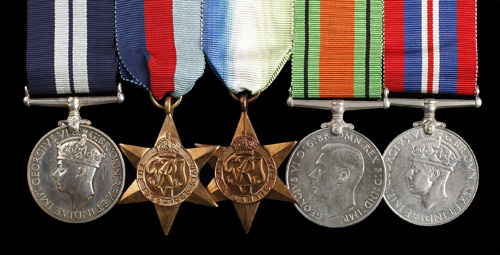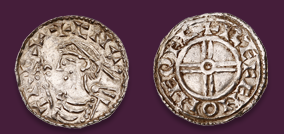
Auction: 1006 - Orders, Decorations, Campaign Medals & Militaria
Lot: 28
The Dieppe Raid D.S.M. Group of Five to Leading Stoker A. Woods, Royal Navy, For His Courage and Repair Work Whilst Under Heavy Fire From the Air and Shore, in H.M.S. Calpe, the H.Q. and Fighter Direction Ship for the Raid. When She Was Holed Beneath the Waterline in the Steering Compartment Woods Saved the Steering Gear and Thus Enabled the Ship and Her Complement to Return Home a) Distinguished Service Medal, G.VI.R. (KX.91619 A. Woods. A/L. Sto.) b) 1939-1945 Star c) Atlantic Star d) Defence and War Medals, very fine or better (5) Estimate £ 4,000-4,500 D.S.M. London Gazette 2.10.1942 Acting Leading Stoker Arthur Woods, C/KX.91619. (H.M.S. Calpe) ´For gallantry, daring and skill in the combined attack on Dieppe´ The Recommendation, dated 22.8.1942, states: ´Untiring devotion to duty and coolness under fire during the whole operations, and in particular when rigging pumping appliances to the steering compartment which had been holed below the waterline and was in danger of flooding, thus putting the steering gear out of action.´ C/KX 91619 Leading Stoker Arthur Woods, D.S.M., served in H.M.S. Calpe for the Commando Raid on Dieppe, 19.8.1942; H.M.S. Calpe was a ´Hunt´ Class Destroyer launched and completed by the end of 1941; she was converted for use specifically for the Dieppe Raid as a HQ and Fighter Direction Ship, July 1942, ´the Jubilee command and control set-up was put in place at this time and their posts during the Raid decided. The Naval and Ground Force Commanders [Captain] Hughes-Hallett and Major-General Roberts would embark in the destroyer H.M.S. Calpe, which would act as headquarters ship and be equipped with extra radio sets for communication with the rest of the invasion fleet, the troops ashore and the UK´ (The Dieppe Raid, R. Neillands, refers). H.M.S. Fernie was set up to duplicate the Calpe in case she was sunk during the raid. During the early hours of the 19th August Calpe helped to lay the smokescreen prior to the beach assaults, subsequently taking up a position with the Fernie from which the Raid Commanders could co-ordinate the proceedings; as it turned out communications between land and sea forces failed with devastating results to the extent that rather than acting as the hub of the operations the Calpe doubled up as a hospital ship, ´the complement, the crew of H.M.S. Calpe numbered fewer than one hundred men. By 0700hrs [an hour and a half into the raid] the decks of this little destroyer were crammed with some two hundred wounded and dying Canadian soldiers brought off every landing beach and delivered to Calpe in the hope of finding doctors. Nor was this all: off Calpe other landing craft were bobbing about their works riddled by shell and machine-gun fire, their decks running with blood, and they too had wounded men in urgent need of assistance.´ (Ibid). This was the chaotic scene that greeted Lord Lovat upon returning from his successful part of the raid, ´Lovat wanted to report his success personally to the two Force Commanders and transfer his severely wounded men onto the destroyer, so he directed his craft to head for the Command ship. However, when they arrived alongside H.M.S. Calpe they found boat loads of wounded men on the same errand and the decks of the destroyer already covered with stretchers bearing dead or wounded. This was Lovat´s first intimation that other parts of Operation Jubilee had not gone as well as his own attack at Varengeville. ´We put seven or eight of our wounded on Calpe, which was a mistake´, he wrote later, ´because she was already full of wounded men and very lucky not to be sunk.´ This rendezvous would have been sometime after 0900hrs... The No. 4 Commando LCAs circled H.M.S. Calpe for about ten minutes, keeping constantly on the move as German fighters and medium bombers were starting to appear off the beaches, bombing and strafing.´ (Ibid). The Calpe and the little fleet that she was now accumulating around her were proving to be an attractive target for both the Luftwaffe and the German shore batteries; as the raid unravelled Roberts gave the order from the Calpe for the general withdrawal, by ´12.20 the officer in charge of the evacuation reported that no more could be done; ten minutes later he withdrew the surviving landing craft. They had, under conditions of utmost difficulty and danger, rescued over 1,000 men. When one considers the tornado of fire that was being directed at the beaches, their accomplishment appears all the more astonishing. At 12.40 the Calpe closed the shore to see if there was any possibility of further rescue. She too came under heavy fire; and no troops could then be seen in a position from which they might be picked up. At about 1pm a general withdrawal of the surviving ships and craft began. German air attacks were now almost continuous. The destroyer Berkeley was so damaged that she had to be sunk by our forces, and the Calpe also was hit.´ (The War at Sea, Vol II, Captain S.W. Roskill, D.S.C., R.N., refers). It was when the Calpe was hit that Woods came to the fore; heavily laden down with wounded and under continual fire from both the shore and the air she nearly shared the fate of her sister ship the Berkeley when one hit holed the steering compartment below the waterline threatening to flood the area and put the steering gear out of action; Woods acted quickly, rigging the pumps and keeping the rushing water at bay, as a consequence she eventually made good her escape. She was the last ship to leave the Dieppe Coast and was under continuous enemy fire virtually all the way back to Portsmouth.
Sold for
£3,000




